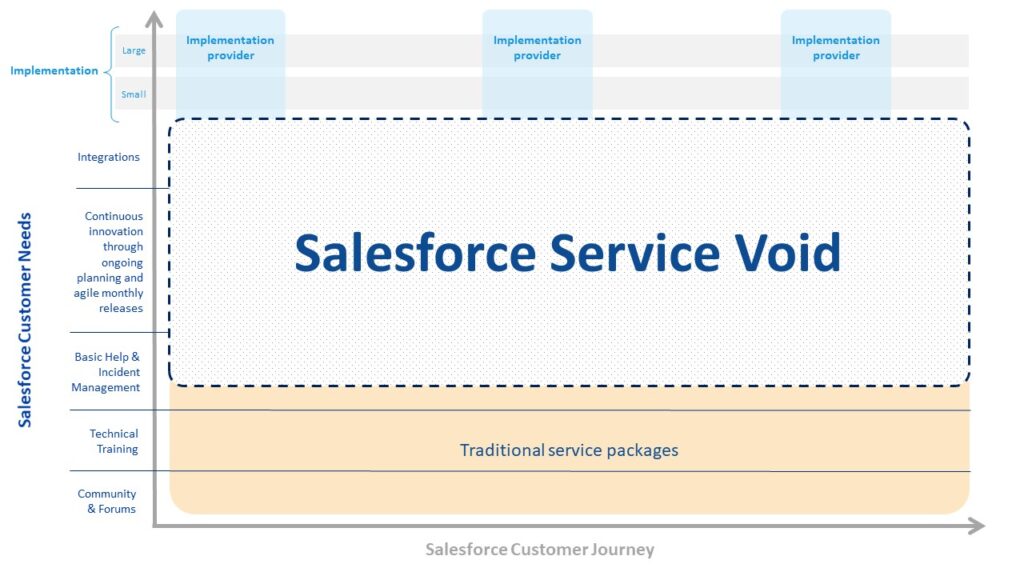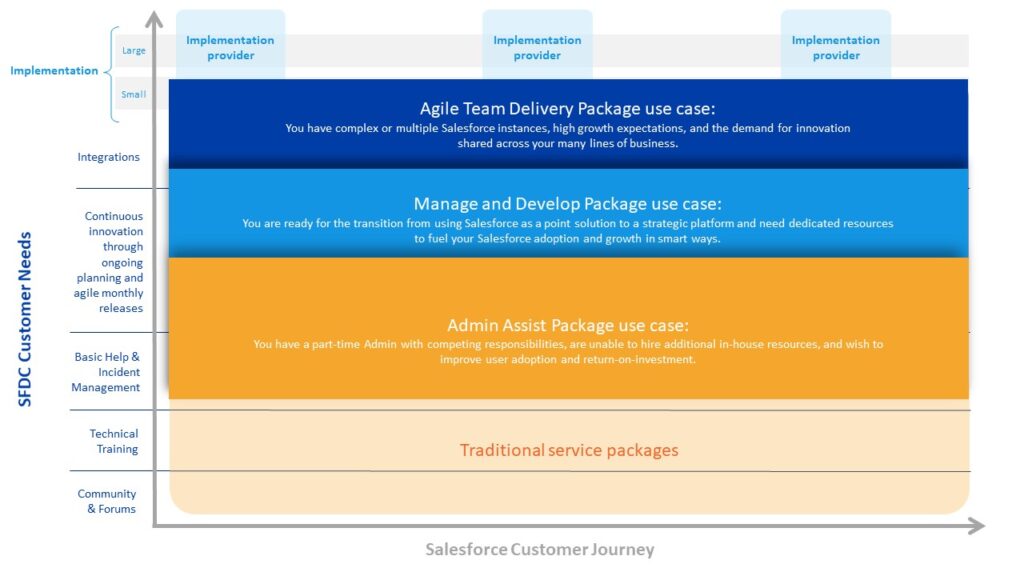Chad Stewart, Vice President, Global SaaS Support Services
Salesforce does an amazing job with innovation, evidenced by their unyielding release schedule and regular onslaught of new features and updates. Their product lineup has grown into much more than just a sales tool. They offer customer service, billing, and integration platforms (to name a few) that provide customers with an enterprise-wide end-to-end solution.
And that’s why Salesforce charges a premium. You are paying for the rapid advancements that come with the world’s most popular and dynamic CRM.
But what good are the new bells and whistles if you don’t have time to configure them? Recently published Salesforce research indicates that companies struggle to keep up with routine Salesforce maintenance and updates.
In this blog, I review the stark realities – the unintended consequences – of signing up with Salesforce and their never-ending expansion. I’ll also show you what you can do to make sure that your company doesn’t fall into the void.
The Salesforce Service Void: What Salesforce Won’t Tell You
A popular phrase in the tech world is “complexity leads to simplicity.” In a perfect world, I agree with that statement. But let’s get real. To make complexity lead to simplicity, you need to work really hard. You need a dedicated team with the right skills. And that applies to managing a Salesforce environment as well. With every new Salesforce release, a new layer of intricacy – and opportunity – is created for its customers.
Salesforce had yet another record year for sales in 2020, which means even more enterprises rely on this service to run their businesses. What Salesforce won’t tell you is that many of these customers will likely fall short of their CRM goals. This negatively impacts ROI and frustrates leaders.
Here are two important stats to consider:
- Only 40% of respondents said their organizations are very good at handling basic administration, while 60% reported delays or confusion
- 38% reported only marginal success with adding new features, and only 8% gave their organizations the top mark for this work
The reasons for these staggeringly high numbers are two-fold: 1) a lack of inhouse Salesforce talent to maintain their Customer 360 platform, and 2) inadequate support from Salesforce experts for continuous innovation. Both have created a daunting challenge for companies that operate in the Salesforce environment.
Because the support requirements grow while access to talent lessens, it creates what I call the Salesforce service void. The more features and platforms that Salesforce adds, the greater the service void.
In the image below, you can see a typical Salesforce customer journey. On the vertical axis, customer needs are listed, starting with basic support and up through integrations and implementations. The horizontal axis is the customer’s journey through time.
The graphic shows a massive hole of unmet needs between technical training and basic break-fix assistance and the intermittent project-based support that comes from implementation providers and consultants. This ever-expanding “service void” prohibits many companies from meaningfully advancing their instance of Salesforce.

Dealing with the Void
To make your Salesforce environment hum and get the most out of your investment, you need to fill the void. What’s the best way to do that? Your options are limited to hiring more staff and working with a third party.
The problem with hiring more staff is that Salesforce professionals are in-demand and expensive. It’s important to keep in mind that for continuous innovation of your Salesforce install, you’ll likely need access to specialized resources (e.g. experience with CPQ, FSL, and integrations). However, you may not have enough work to justify a full-time hire. Spending a fortune for new personnel when there’s not enough work for that person long term is simply bad business.
The other option is to engage with an outside firm to augment your current staff. Implementation providers and consultants offer immediate support and capabilities, but there’s a problem with this approach. Once the project is done, they move on to the next big project and take their knowledge and skills with them. You then get to manage the solution on your own – and get sucked back into the void.
For those of you who have endured implementations and one-off projects, you know that improvements and modifications will be needed months down the road. In this scenario, your options are to either enter into another costly one-off engagement or figure it out on your own and hope for the best. Neither of which is ideal.
Now, in all fairness to Salesforce, the company does offer two ongoing service packages that provide some value: Premier and Signature (formerly Premier Plus). Adding these service options is expensive at 20% and 30% of net annual spend, respectively. These service packages allow customers to log tickets, access the knowledge base and training modules, and receive recommendations to address their issues.
But buyers take note: with Premier and Signature support packages, the customer must make the changes themselves. Salesforce only provides suggestions and instructions. Its packages do not provide what we call “hands on keyboards,” which is a person who understands your business needs and delivers a high-quality solution.
Salesforce wants you to do that on your own. At those high premiums, that’s a bit rich. If you need live, helpful assistance, then Premier and Signature are likely not a good fit.
Filling the Salesforce Service Void
In my experience with Salesforce over the past decade, I have found that to get the most out of your Salesforce investment, you must calibrate continuous innovation to the pace that is right for your company. The question all companies should ask is, “How do we maintain and improve our Salesforce infrastructure in the most cost-effective manner?”
My answer is always to begin by talking with Salesforce experts who actually understand and fill the service void. Managed services from Spinnaker Support address the challenges and requirements needed to have an exceptional Salesforce system for the long term. Our certified experts provide direct support, which means we do the heavy lifting for you.
We’ve specifically designed our Salesforce managed services packages, shown below, to address the service void and fill a range of needs from admin assistance to full agile delivery. Our packages are tailored to your specific needs and to work tightly in tandem with your existing support teams.

Start Your New Journey to an Amazing Salesforce Experience
Having dedicated a large part of my career to the Salesforce ecosystem, I’m convinced that it’s absolutely the best enterprise platform available. I also know that customers fail to take advantage of all it has to offer, which is why we’ve assembled a team geared to address and fill the service void. In the coming months, I’ll share compelling customer stories and ROI calculations that demonstrate how our Center of Excellence framework delivers new functionality to our clients.
If you would like to learn more about how this cost-effective approach will bolster your Salesforce investment through a state of continuous innovation, please contact us today!


